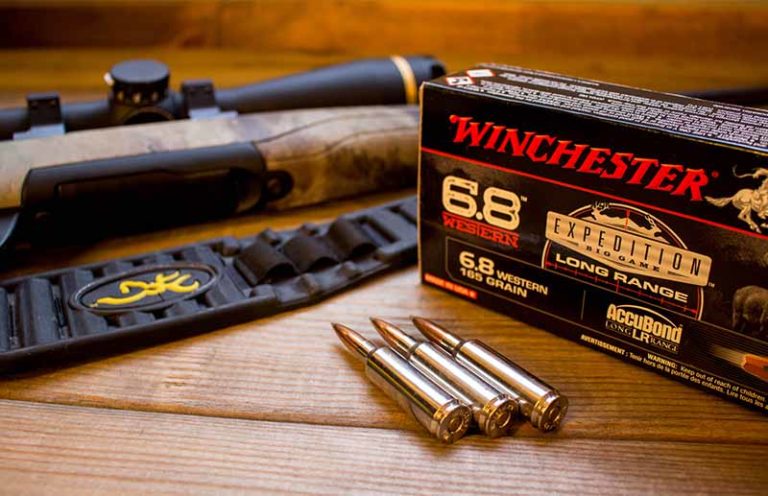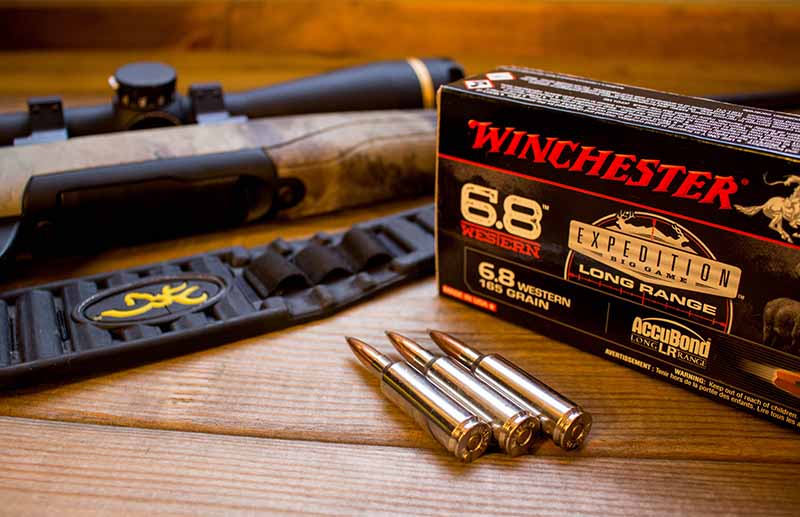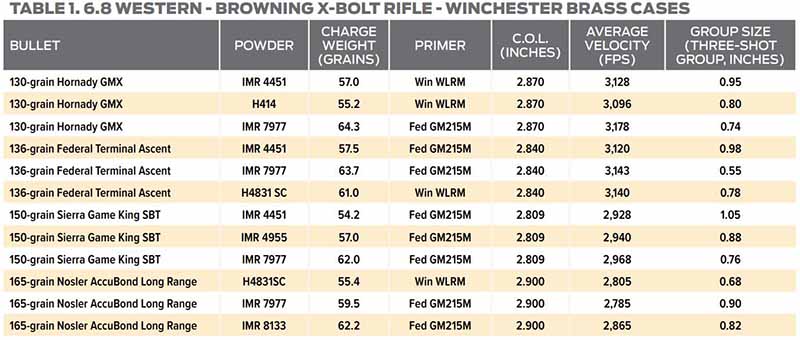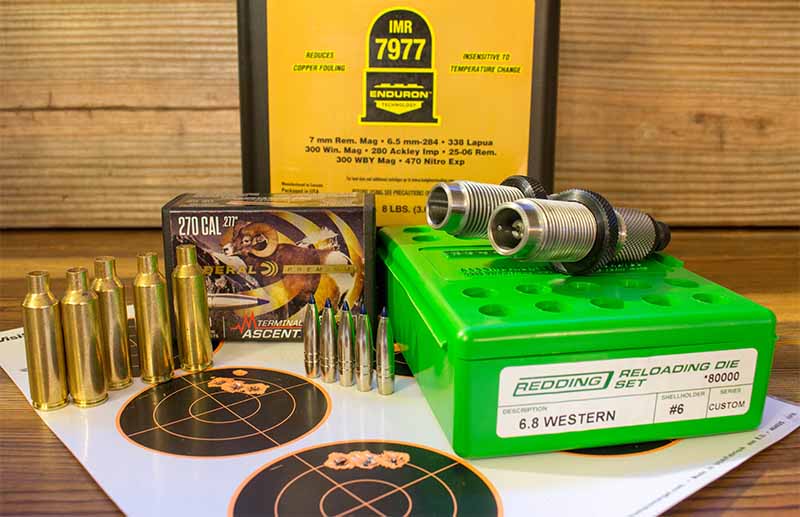
As hard-hitting a belted magnums and ballistically talented as the 6.5 crowd, the 6.8 Western is a show stopper in the field.
Why The 6.8 Western Fills An Important Niche:
- At 500 yards, the cartridge delivers more energy on target than the .300 Win. Mag.
- It's trajectory is on par with the 6.5 PRC and .300 Win. Mag.
- Yet, the cartridge generally produces less felt recoil and fits in a short action.
- A solid 130-grain to 165-grain bullet selection, the 6.8 is suitable for all North American medium and big game.
How The 6.8 Western Compares
As far as current factory ammunition goes, I tested the 165-grain bonded core at 2,970 fps and a 175-grain cup-and-core bullet (Sierra bullets have a stellar reputation) at a muzzle velocity of 2,830 fps. Let’s look at how these two bullets fare downrange and how they compare to other popular cartridges.

The 6.8 Western with the 165-grain Nosler AccuBond Long Range load will give a trajectory on par with both the 6.5 PRC with a 143-grain ELD-X and the .300 Winchester Magnum with a 180-grain Swift Scirocco II. With all three zeroed at 200 yards, the 6.8 Western and 6.5 PRC are within .3 inch out to 500 yards, with velocities so close it’s not funny, though the 6.8 Western has over 250 ft-lbs more energy at 500 yards. And though it is very difficult to quantify with energy figures alone, it is not difficult to envision the penetration advantage of an additional 22 grains of bullet, as the 165-grain .277 has an S.D. of .307 vs. the 6.5mm 143-grain’s .293 figure.
Looking to the highly popular .300 Winchester Magnum and the 180-grain Swift Scirocco II, as loaded by Federal to a muzzle velocity of 2,960 fps, you’ll see the trajectory nearly identical to the 6.8 Western. At the 500-yard mark, the .300 Winnie hits only 2.5 inches lower than the 6.8 Western, though the larger cartridge has a bit less energy at that distance. If you are a holdover-type shooter, think of the trajectory like this: with a 200-yard zero, you’ll need 6 inches of holdover at 300 yards, 18 inches at 400 yards, and 36 inches at 500 yards.
Comparing the three cartridges’ energy at 500 yards, you see the 6.8 Western delivering 1,863 ft-lbs, the .300 Winchester Magnum 1,796 ft-lbs, and the 6.5 PRC 1,604 ft-lbs. The numbers for the 175-grain load drop off a bit, with the heavier bullet hitting 4.5 inches lower than the 165-grain at 500 yards, and at that distance, the heavier bullet retains about 100 ft-lbs less than the lighter load. Comparing the three cartridges’ felt recoil, I will confidently say that the 6.8 Western has the least felt recoil by a large margin in my experiences with them in different rifles.
I tested the two factory loads’ velocities on my chronograph and found them consistent, though slightly lower than advertised. The Browning X-Bolt drove the 165-grain load to an average muzzle velocity of 2,918 fps, 52 fps slower than indicated, and the 175-grain load left the muzzle at an average speed of 2,770 fps, 60 fps slower than advertised. I’ve seen worse deviations, so I wasn’t overly concerned; the extreme velocity spread was inside of 20 fps, and that consistency is indicative of the accuracy I observed.

What we then have is a cartridge housed in a lighter, short-action receiver (the 6.5 PRC is too long to fit in a short-action rifle), which gives a minimal amount of recoil while very nearly mirroring the performance of the venerated .300 Winchester Magnum in every manner, save frontal diameter. I’m a huge fan of the .300 Winchester Magnum, as well as the .30-06 Springfield and .308 Winchester, but unless you plan to use the 200- and 220-grain bullets, you could make the case of switching to the lighter-recoiling 6.8 Western. You get more bang for the buck (pun intended), though ammunition availability is a factor, especially in our current environment.
But, while the heavy bullets are great for bigger game species and for shooting at longer ranges, will the 6.8 Western also cover the same ground as the .270 Winchester and .270 WSM? Let’s take a look at handloading for the 6.8 Western, with both the heavy bullets and with the standard 130- through 150-grain bullets so popular and readily available.
Reloading the 6.8 Western
Grabbing a set of Redding 6.8 Western reloading dies and some Winchester component brass, I set out to develop a few handloads that would maximize the new cartridge’s capabilities. With load data provided by Hodgdon — covering the Hodgdon, IMR, and Winchester trio of powder brands under its roof — and a versatile selection of .277-caliber bullets that would cover almost all North American game species, I cooked up a variety of test loads. For projectiles, I grabbed a quartet I felt would cover the gamut of species you’d possibly take with the 6.8 Western. The 165-grain Nosler AccuBond Long Range would be the heavyweight choice, but the 150-grain Sierra GameKing spitzer boattail, 136-grain Federal Terminal Ascent, and 130-grain Hornady GMX would complete the range of bullet weights.
To spark the 6.8, I used Winchester’s WLRM and Federal’s GM215M Gold Medal Match large rifle magnum primers in Winchester cases. Several powders would have been suitable for the 6.8 Western, but certain ones stood out as the best choices for my particular rifle. Hodgdon’s H414 and H4831SC were excellent choices, and the IMR Enduron powders, including IMR 4451, IMR 4955, IMR 7977, and the slow-burning IMR 8133, gave terrific results. The 6.8 Western likes powders on the medium to slow burn rate from IMR 4350, H4350, and Winchester’s StaBall 6.5, all the way up through Hodgdon H1000 and RETUMBO.

Though I had good results with several, were I forced to pick the powder which performed best in my test gun, I’d look to IMR 7977. It wasn’t always the fastest, but it was the most consistent in both accuracy and velocity. With the 165-grain Nosler AccuBond Long Range bullets, IMR 8133 gave the highest velocities, as it is the slowest burning of the powders tested. The factory stuff was a bit faster than my handloads — as expected — but I would still be satisfied with the speeds my handloaded ammunition generated. I used a 2.900-inch cartridge overall length for the 165-grain ABLRs, as the rifle seemed to like that length best, but the other bullets required a bit shorter C.O.L. The Nosler AccuBond Long Range and Federal Terminal Ascent bullets produced the best accuracy. They would be my choice for shots at longer ranges, letting the species’ size and tenacity dictate the choice.
What I ended up with were handloads perfectly suited for hunting nearly all game species you’d want to use the 6.8 Western for; though it would work, I suppose the cartridge might not be considered a sound choice for prairie dogs and other small varmints. The 130-grain bullets will handle whitetails without issue. With the 136-grain Terminal Ascent, you’ve got an excellent choice for pronghorns, sheep, and other similar species. The 165-grain Nosler AccuBond could handle the bears, larger cervids, and a wide selection of African game species as well.
Concluson
Considering that the .270 Winchester and .270 WSM cannot stabilize the longer projectiles without a replacement barrel and having seen the effects of the heavier projectiles on game animals, the 6.8 Western’s ability to mimic the terminal effects of the larger 7mm- and .30-caliber cartridges make it a viable design. In a saturated market with excellent cartridges, the 6.8 Western brings a unique sense of balance, performance, and versatility usually reserved for classic designs. I have never been overly enthusiastic about the Winchester Short Magnum cartridges, and the 6.8 Western is undoubtedly a part of that family, even if the name doesn’t reflect it. But there is something different and unique about this one. I had none of the feeding issues I’ve experienced with the .300 WSM and .270 WSM; perhaps that slightly relocated shoulder is playing a part in that.

Where the 7mm WSM and .325 WSM have lost the shooting public’s attention, and the WSSM cartridges have all but faded into obscurity, I feel the 6.8 Western will prove to be a popular choice, as it fills a niche which, in my opinion, has long been needed.
Editor's Note: This article is from Gun Digest 2022, 76th Edition, available at GunDigestStore.com.
Raise Your Ammo IQ:
- Beyond The 6.5 Creedmoor: The Other 6.5 Cartridges
- The Lonesome Story Of The Long-Lost 8mm
- Why The .300 H&H Magnum Still Endures
- .350 Legend Vs .450 Bushmaster: Does One Win Out For Hunting?

Next Step: Get your FREE Printable Target Pack
Enhance your shooting precision with our 62 MOA Targets, perfect for rifles and handguns. Crafted in collaboration with Storm Tactical for accuracy and versatility.
Subscribe to the Gun Digest email newsletter and get your downloadable target pack sent straight to your inbox. Stay updated with the latest firearms info in the industry.

![Best Concealed Carry Guns In 2025 [Field Tested] Wilson Combat EDC X9S 1](https://gundigest.com/wp-content/uploads/Wilson-Combat-EDC-X9S-1-324x160.jpg)


![Best 9mm Carbine: Affordable PCCs [Tested] Ruger Carbine Shooting](https://gundigest.com/wp-content/uploads/Ruger-Carbine-Shooting-100x70.jpg)
![Best AR-15: Top Options Available Today [Field Tested] Harrington and Richardson PSA XM177E2 feature](https://gundigest.com/wp-content/uploads/Harrington-and-Richardson-PSA-XM177E2-feature-100x70.jpg)

The comment about the 6.5 prc not being short action is not correct. Most are using short actions for this cartridge. The magazines and mag well are either modified or different to support the longer length of the 6.5 prc. My Bergara B14 chambered it this cartridge is short action.
What is the expected barrel life for good accuracy?
3020 FPS with my .270 Win, 150 Berger vld’s and Reloder 26. 3012 with Nosler Partitions. No need for a 6.8 for this guy.